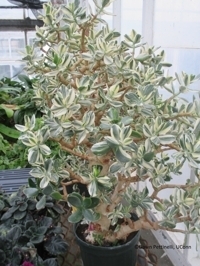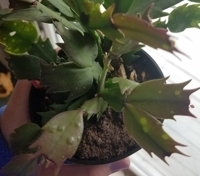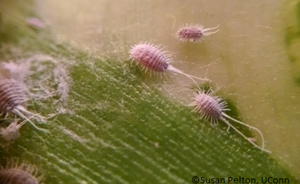Crassula ovata

Jade plants have been a favorite houseplant in the Americas and Europe for over 100 years and are commonly used as Bonsai. These easy-to-grow succulents are native to South Africa and Mozambique. In some cultures, they are considered symbols of good luck, prosperity, or friendship. Plants are fairly undemanding and respond well in situations with moderate light and moisture and over a wide range of temperatures. While jade plants are tolerant of less than favorable conditions, they will be happier when provided with more optimum conditions. Jade plants can live a long time and may reach 5' or so in height. Mature plants produce starry white or pink blossoms during the winter months.
Potting Soil Mix
Potting mixes for jade plants need to be very well draining. Because plants tend to be top-heavy, commercial potting mixes for succulent usually contain sand, grit, rock chips or other weighty materials. A source of organic matter such as peat moss, coconut coir or composted bark will also be in the mix and sometimes bark chips or perlite is added for improved drainage. If not listed on the package, mix in two tablespoons of ground limestone for every gallon of potting mix as jade plants prefer a pH of around 6.5. Usually plants need repotting every 2 to 3 years. Clay or ceramic pots are ideal to use for these hefty succulents.
Fertilization
Jade plants should be fertilized according to their growth cycles as well. Just feed plants every other month with a flowering houseplant fertilizer from April through September.
Light
In their natural habitats, they grow in dry but very sunny sites. Jade plants enjoy a sunny, southern exposure but do not move plants from subdued lighting into a full sun situation. Instead, gradually expose them to brighter light so leaves will not get sunburn. Sometimes in very high light situations, the leaves develop a red tinge around their edges. Keep plants around 60 to 70°F during the day but temperatures can drop into the 50s at night. Cooler nights and avoidance of supplemental light after the sun sets encourages bud formation.
Watering
Overwatering is the biggest killer of houseplants, especially succulents like jade plants. Succulents store water in their leaves, stems and roots. When plants are actively growing which is usually from about mid-March through mid-October, they like to be watered enough so the soil remains moderately moist. Some like to really soak plants once a week or so and let them drain thoroughly so no water accumulates in the saucer. Once the top inch or so of soil feels dry to the touch, this watering procedure is repeated. Watering may need to be done more frequently in hot, dry weather.
During the other 6 months of the year when temperatures are cooler and the sun’s rays are weaker and days are shorter, jade plants slow their growth and require less water. Do not let plants completely dry out but reduce the amount and frequency of watering. If you are not giving the plant enough water, often it will begin losing leaves and may shrivel.
Overwatered plants may start to exhibit signs of root rot or a condition known as edema. Water taken up by the roots is greater than the plant can use or be transpired through the stomates. This encourages blisters to form on the leaves that turn into corky brown spots. Sometimes, small white spots that rub off easily appear on the leaves. This again can occur when plants have more water than they need so some water is released through the leaves along with plant minerals. These two problems most often occur in late winter during cool, cloudy weather.

Propagation
Jade plants are easy to propagate, are sometimes referred to as friendship plants, and are perfect for sharing. Simply remove a few of the opposing leaf pairs, leave in an open area for the end of the leaves to callous over and then stick them in some moistened potting mix in a small container. Put a clear plastic bag over it to retain moisture. Roots should form in a few weeks and then the small plants can be potted up.
Diseases and Insects
Jade plants may suffer from root rot if the soil does not drain well or if they are overwatered. Bacterial soft rot may cause plant tissues of the stems and branches to grow soft and collapse. There is no control method and infected plants should be discarded. Powdery mildew (genus Sphaerotheca) is a fungus that causes scabby or corky areas to develop on leaves. Horticultural oil can be used to treat powdery mildew.
Crassula ovata is susceptible to mealybugs, unarmored scale insects that are common pests of succulents and other houseplants. The nymphs of mealybugs pierce the outer layer of plant tissue, feed on the sap, and excrete honeydew which can cause sooty mold. Wiping the infected area with a cotton ball soaked in rubbing alcohol can help control them.

Varieties
The leaves of the common jade plant are a rich jade green. ‘Variegata’ has green and cream leaves. ‘Tricolor’ jade plants grow 2-4' tall and have lovely pink and cream streaks on green leaves. ‘Bronze Beauty’ has small coppery colored leaves and is very slow growing. 'Hummel's Sunset' has green leaves with edges of yellow, red, and orange. Lord of the Ring fans might seek out ‘Hobbit’ with its tiny, curled leaves or ‘Gollum’, a curious plant sporting long, fingerlike leaves.
Despite good cultural practices, pests and diseases at times may appear. Chemical control should be used only after all other methods have failed.
For pesticide information or other questions please call toll free: 877-486-6271.